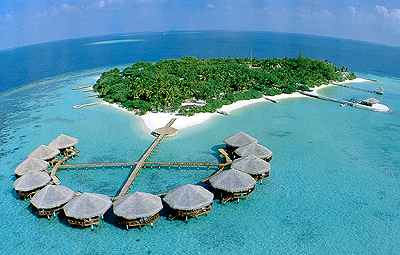|
|
The Maldives Approx. 1200 islands, of which a few are merely large
sandbanks, divided into
The tourists occupy their own resort islands, separated from the local population. Personal contacts with the Maldivians, who are rather reserved, is rather difficult. Until today 65 Resort Islands for the tourists have been developed. - We have selected for you seven resorts which we would like to present to you. The Maldives are not only a dream destination for Scuba Diving, Snorkeling and Windsurfing. Just to bathe in clear blue waters on a beach with coarse coral white sand is a sensation. - It is also the perfect retreat for those wishing to get away from it all and enjoy a totally relaxed and unsophisticated way of life and just lazing under a palm tree.
Historical Summary It is assumed that the Maldives have been formed about
100.000 years ago when once sunken masses of land through tremendous geological movements
were lifted just under or above the sea level. In the decades that followed the corals
have made their contribution to the Maldives of today. At the end of the 16th Century the Portuguese tried to take up their
position on the Maldives, thanks to foreign support the Maldivians were able to chase the
Portuguese away. In 1887 an English fleet landed in Male. A treaty was signed with the ruling sultan who could keep his position but had to grant to the British a yearly payment of tribute and the island of Gan in the south of the Maldives. In 1968 the Islamic Republic was proclaimed. Travel Advisories Beach & Sea The house reefs around the islands bring about a very calm sea ideal for snorkelling and swimming. Due to the corals, bathing shoes are recommended. You do not have to be a diver to enjoy the many wonders of the tropical sea, while snorkelling you can also experience the underwater world. If you do not take along masks, snorkels, and flippers, they can be rented on the islands for about US $ 7.-- per day. FKK and "Topless" are not permitted on the Maldives and offenders will be fined, the same goes for harpooning fish and destroying corals. Climate Due to its proximity to the equator the Maldives experience an average humidity of about 80 percent during the whole year and practically the same air (29� C.) and water (28� C.) temperatures. The Southwest monsoon from May to November brings relatively wet air masses, where as the Northeast monsoon from December till April bestows dry weather to the Maldives. Currency The local currency is the Mal. Rufiyaa. As per law the prices in all tourist resorts
and hotels have to be quoted in US dollars and paid by foreign visitors in foreign
currency. All major credit cards are accepted at major hotels and resorts, however most of
the resorts will add a surcharge up to 6 percent for payments with credit cards. Electricity The Maldives uses 220-240 volts, alternating current. The outlets are tree-pronged. All the resorts have their own generator(s). Embarkation Tax Upon departure at the airport an embarkation tax of US $ 10.-- per person will be levied. Entertainment For people who are looking for entertainment and nightlife the Maldives are not the ideal destination to spend their holidays. In the evening after dinner one spends an hour or so cosily at the resort bar or sits on the beach under the sparkling stars. Excursions Excursions are regularly organised to the neighbouring islands and also to Male. Very popular is the night fishing followed by a barbecue on the beach. Import Restrictions Please note that the importation of products from pork meet, alcohol, pornographic material, weapons, narcotics, and objects of a religious character are prohibited. - The Maldives have a very severe narcotic law. Language The local language is called Dhivehi. On all the resort islands English is spoken. Sports Visa Regulations & Vaccination As a rule visitors to the Maldives do not need an entry visa for a stay of up to four weeks, however the passport has to be valid for a least six months exceeding the date of leaving the Maldives. A vaccination certificate is only required for visitors arriving from cholera, yellow fever or malaria infested countries. What to wear T-shirts, light cotton dresses of the drip-try, wash-and-wear variety, shorts,
light-weight suits are the most comfortable year round attire. In addition swimming gear
and a light pullover. Sun-glasses and a wide brimmed beach hat as well as enough sun cream
with a high protection factor should not be missing in your luggage. |
||
|

